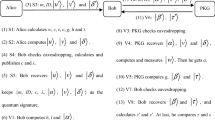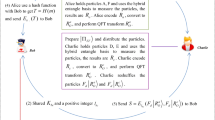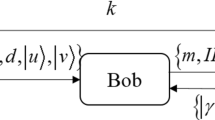Abstract
Recently, many quantum digital signature (QDS) schemes have been proposed to authenticate the integration of a message. However, these quantum signature schemes just consider the situation for bit messages, and the signing-verifying of one-bit modality. So, their signature efficiency is very low. In this paper, we propose a scheme based on an application of Fibonacci-, Lucas- and Fibonacci-Lucas matrix coding to quantum digital signatures based on a recently proposed quantum key distribution (QKD) system. Our scheme can sign a large number of digital messages every time. Moreover, these special matrices provide a method to verify the integration of information received by the participants, to authenticate the identity of the participants, and to improve the efficiency for signing-verifying. Therefore, our signature scheme is more practical than the existing schemes.
Similar content being viewed by others
References
William S. Cryptography and Network Security: Principles and Practice. 2nd ed. New Jersey: Prentice Hall, 2003. 67–68
Rivest R L, Shamir A, Adleman L. A method for obtaining digital signatures and public-key cryptosystems. Commun ACM, 1978, 21: 120–126
Cramer R, Shoup V. Signature schemes based on the strong RSA assumption. ACM Trans Inf Syst Secur, 2000, 3: 161–185
ElGamal T. A public key cryptosystem and a signature scheme based on discrete logarithms. In: Proceedings of Workshop on the Theory and Application of Cryptographic Techniques. Berlin: Springer, 1984. 10–18
Shor P W. Polynomial-time algorithms for prime factorization and discrete logarithms on a quantum computer. SIAM Rev, 1999, 41: 303–332
Amiri R, Andersson E. Unconditionally secure quantum signatures. Entropy, 2015, 17: 5635–5659
Gottesman D, Chuang I. Quantum digital signatures. arXiv:quant-ph/0105032, 2001
Chaum D, Heyst E V. Group signatures. In: Advances in cryptography-EUROCRYPT’91. Berlin: Springer, 1991. 257–265
Zeng G H, Keitel C H. Arbitrated quantum-signature scheme. Phys Rev A, 2002, 65: 1–6
Wallden P, Dunjko V, Kent A, et al. Quantum digital signatures with quantum-key-distribution components. Phys Rev A, 2015, 91: 042304
Shi J J, Shi R H, Guo Y, et al. Batch proxy quantum blind signature scheme. Sci China Inf Sci, 2013, 56: 052115
Dunjko V, Wallden P, Andersson E. Quantum digital signatures without quantum memory. Phys Rev Lett, 2014, 112: 040502
Collins R J, Donaldson R J, Dunjko V, et al. Realization of quantum digital signatures without the requirement of quantum memory. Phys Rev Lett, 2014, 113: 040502
Arrazola J M, Wallden P, Andersson E. Multiparty quantum signature schemes. Quantum Inf Comput, 2016, 6: 0435
Wang T Y, Cai X Q, Ren Y L, et al. Security of quantum digital signatures for classical messages. Sci Rep, 2014, 5: 9231
Wen X J, Niu X M, Ji L P, et al. A weak blind signature scheme based on quantum cryptography. Optics Commun, 2009, 282: 666–669
Li F G, Shirase M, Takagi T. Cryptanalysis of efficient proxy signature schemes for mobile communication. Sci China Inf Sci, 2010, 53: 2016–2021
Amiri R, Wallden P, Kent A, et al. Secure quantum signatures using insecure quantum channels. Phys Rev A, 2016, 93: 032325
Yin H L, Fu Y, Chen Z B. Practical quantum digital signature. Phys Rev A, 2016, 93: 032316
Donaldson R J, Collins R J, Kleczkowska K, et al. Experimental demonstration of kilometer-range quantum digital signatures. Phys Rev A, 2016, 93: 012329
Simon D S, Lawrence N, Trevino J, et al. High-capacity quantum Fibonacci coding for key distribution. Phys Rev A, 2013, 87: 032312
Simon D S, Fitzpatrick C A, Sergienko A V. Discrimination and synthesis of recursive quantum states in highdimensional Hilbert spaces. Phys Rev A, 2015, 91: 043806
Esmaeili M, Moosavi M, Gulliver T A. A new class of Fibonacci sequence based error correcting codes. Cryptogr Commun, 2017, 9: 379–396
Vajda S. Fibonacci and Lucas Numbers, and the Golden Section: Theory and Applications. New York: Ellis Horwood Ltd.-Halsted Press, 1989
Mishra M, Mishra P, Adhikary M C, et al. Image encryption using Fibonacci-Lucas transformation. Int J Cryptogr Inf Secur, 2012, 2: 131–141
Stakhov A P. Fibonacci matrices, a generalization of the cassini formula and a new coding theory. Chaos Soliton Fract, 2006, 30: 56–66
Rey A, Sanchez G. On the security of the golden cryptography. Int J Netw Secur, 2008, 7: 448450
Bennett C H, Brassard G. Quantum cryptography: public-key distribution and coin tossing. In: Proceedings of IEEE International Conference on Computers, Systems and Signal Processing, Bangalore, 1984. 175–179
Ekert A K. Quantum cryptography based on Bell’s theorem. Phys Rev Lett, 1991, 67: 661–663
Vogel H. A better way to construct the sunflower head. Math Biosci, 1979, 44: 179–189
Wang T Y, Cai X Q, Zhang R L. Security of a sessional blind signature based on quantum cryptograph. Quant Inf Process, 2014, 13: 1677–1685
Wang T Y, Wen Q Y. Fair quantum blind signatures. Chin Phys B, 2010, 19: 060307
Wen X J, Chen Y Z, Fang J B. An inter-bank E-payment protocol based on quantum proxy blind signature. Quant Inf Process, 2013, 12: 549–558
Cai X Q, Zheng Y H, Zhang R L. Cryptanalysis of a batch proxy quantum blind signature scheme. Int J Theor Phys, 2014, 53: 3109–3115
Acknowledgements
Hong LAI was supported by Fundamental Research Funds for the Central Universities (Grant No. XDJK2016C043), 1000-Plan of Chongqing by Southwest University (Grant No. SWU116007), and Doctoral Program of Higher Education (Grant No. SWU115091). Mingxing LUO was supported by Sichuan Youth Science & Technique Foundation (Grant No.2017JQ0048). Josef PIEPRZYK was supported by National Science Centre, Poland (Grant No. UMO-2014/15/B/ST6/05130). Shudong Li was supported by National Natural Science Foundation of China (Grant Nos. 61672020, 61662069, 61472433), Project Funded by China Postdoctoral Science Foundation (Grant Nos. 2013M542560, 2015T81129) and A Project of Shandong Province Higher Educational Science and Technology Program (Grant Nos. J16LN61, 2016ZH054). The paper was also supported by A Project Funded by the Priority Academic Program Development of Jiangsu Higher Education Institutions (PAPD) and Jiangsu Collaborative Innovation Center on Atmospheric Environment and Equipment Technology (CICAEET).
Author information
Authors and Affiliations
Corresponding authors
Additional information
Conflict of interest The authors declare that they have no conflict of interest.
Rights and permissions
About this article
Cite this article
Lai, H., Luo, M., Pieprzyk, J. et al. An efficient quantum blind digital signature scheme. Sci. China Inf. Sci. 60, 082501 (2017). https://doi.org/10.1007/s11432-016-9061-4
Received:
Accepted:
Published:
DOI: https://doi.org/10.1007/s11432-016-9061-4




